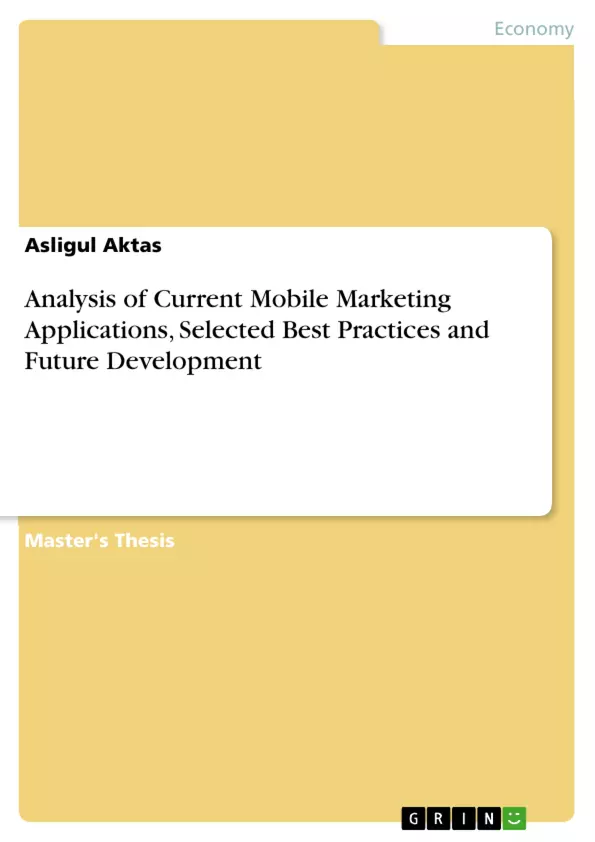This study fundamentally attempts to investigate current mobile marketing and advertising market, to examine current mobile marketing applications and to analyze three selected Best Practices and the future development of mobile marketing.
The study consists of five main sections. First section consists of two parts, namely Introduction and Problem Statement. Introduction part covers a brief presentation about the subject of the study and the research objectives. And Problem Statement part discusses the stimulating factors to apply this research. The next section, which is Background Information, discusses the structural frame and the distinctive aspects of Mobile Marketing, the factors influencing consumer attitude towards mobile marketing, as well as measurement fundamentals of mobile marketing campaigns. This is followed by an Analysis of Current Mobile Marketing Applications including three selected Best Practices. Subsequently, Future Development of Mobile Marketing section explores the anticipations of the way towards which Mobile Marketing progresses and how the mobile technologies shape the development. Too, Key Success Factors of Mobile Marketing are investigated in this section. Finally, the fifth section concludes with a discussion about key findings of the study. Limitations of the Research and Recommendations for Further Research are provided to highlight the study.
The writer pays attention that the study comprises her own reflections and original contributions.
Keywords: Mobile Advertising, Mobile Marketing Applications, Best Practices in Mobile Marketing, Key Success Factors of Mobile Marketing, Future Developments on Mobile Marketing
Inhaltsverzeichnis (Table of Contents)
- A. Introduction
- I. Problem Statement
- B. Background Information
- I. Distinctive Aspects of Mobile Marketing
- II. Mobile Marketing Ecosystem
- III. Factors Effecting Consumer Attitude towards Mobile Marketing
- IV. Measurement Fundamentals of a Mobile Marketing Campaign
- C. Analysis of Current Mobile Marketing Applications
- I. SMS/MMS Marketing
- 1. SMS/MMS Messages and Newsletters
- 2. Mobile Coupons
- 3. Text-to-Win Campaigns
- II. Interactive billboards
- III. Quick Response (QR) Codes
- IV. Bluetooth Marketing
- V. Mobile Web Sites
- VI. Augmented Reality
- VII. Advergaming
- VIII. Ring Back Tones
- IX. GPS Marketing
- X. Mobile TV
- D. Analysis of Selected Three Best Practices
- I. "Tonla Kazan" (Tone & Win) - Turkcell
- II. "Together Everywhere" - Puma
- III. Lonely Planet Compass Guide
- 3E. Future Development of Mobile Marketing
- I. Mobile Outlook
- II. Key Success Factors of Mobile Marketing
- 1. Design
- 2. Implementation
- III. Future Transition of Mobile Marketing
- F. Conclusion
- I. Limitations of the Research
- II. Recommendations for Further Research
- The distinctive features and ecosystem of mobile marketing
- Factors influencing consumer attitudes towards mobile marketing
- Analysis of diverse mobile marketing applications and their effectiveness
- Evaluation of successful mobile marketing campaigns
- Future trends and key success factors for mobile marketing
Zielsetzung und Themenschwerpunkte (Objectives and Key Themes)
This thesis aims to analyze current mobile marketing applications, selected best practices, and future development. The work explores various aspects of mobile marketing, providing insights into its potential and challenges.Zusammenfassung der Kapitel (Chapter Summaries)
The introduction lays out the problem statement and provides a brief overview of the research. Chapter B delves into background information, outlining the unique characteristics of mobile marketing and its complex ecosystem. The chapter further investigates factors that affect consumer attitudes toward mobile marketing and examines measurement methods used to assess mobile marketing campaigns. Chapter C presents an in-depth analysis of current mobile marketing applications, covering various methods such as SMS/MMS marketing, interactive billboards, QR codes, Bluetooth marketing, mobile websites, augmented reality, advergaming, ring back tones, GPS marketing, and mobile TV. Chapter D explores three prominent best practices in mobile marketing, showcasing successful campaigns by companies like Turkcell, Puma, and Lonely Planet. Chapter 3E looks towards the future of mobile marketing, discussing the mobile outlook, key success factors for successful campaigns, and the anticipated transition of mobile marketing in the future.Schlüsselwörter (Keywords)
This research focuses on various aspects of mobile marketing, encompassing themes such as consumer attitudes, application analysis, best practices, future trends, and key success factors. The study draws upon concepts like SMS/MMS marketing, interactive billboards, QR codes, Bluetooth marketing, mobile websites, augmented reality, advergaming, ring back tones, GPS marketing, mobile TV, and mobile outlook, among others.- Arbeit zitieren
- M.A. Asligul Aktas (Autor:in), 2010, Analysis of Current Mobile Marketing Applications, Selected Best Practices and Future Development, München, GRIN Verlag, https://www.grin.com/document/150756



